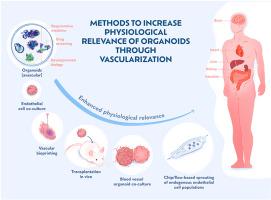下一代血管化类器官构建体的工程设计
IF 4.9
2区 医学
Q1 CARDIAC & CARDIOVASCULAR SYSTEMS
引用次数: 0
摘要
器官组织是一种自组织三维细胞培养模型,对于研究多种物种(尤其是人类)的发育和疾病的内在机制非常有价值。这些三维工程组织可以在体外模拟人体器官的结构和功能。生成器官组织的方法已经有了很大改进,在不同方面与体内器官组织更加相似。目前类器官模型的主要局限之一是缺乏功能性血管区。在此,我们将讨论在类器官系统中生成可灌注血管网络的方法。加入灌注血管区明显提高了类器官系统的生理相关性,是建立下一代更复杂的体外系统的关键一步,可用于发育、临床和药物开发环境。本文章由计算机程序翻译,如有差异,请以英文原文为准。

Engineering next generation vascularized organoids
Organoids are self-organizing 3D cell culture models that are valuable for studying the mechanisms underlying both development and disease in multiple species, particularly, in humans. These 3D engineered tissues can mimic the structure and function of human organs in vitro. Methods to generate organoids have substantially improved to better resemble, in various ways, their in vivo counterpart. One of the major limitations in current organoid models is the lack of a functional vascular compartment. Here we discuss methodological approaches to generating perfusable blood vessel networks in organoid systems. Inclusion of perfused vascular compartments markedly enhances the physiological relevance of organoid systems and is a critical step in the establishment of next generation, higher-complexity in vitro systems for use in developmental, clinical, and drug-development settings.
求助全文
通过发布文献求助,成功后即可免费获取论文全文。
去求助
来源期刊

Atherosclerosis
医学-外周血管病
CiteScore
9.80
自引率
3.80%
发文量
1269
审稿时长
36 days
期刊介绍:
Atherosclerosis has an open access mirror journal Atherosclerosis: X, sharing the same aims and scope, editorial team, submission system and rigorous peer review.
Atherosclerosis brings together, from all sources, papers concerned with investigation on atherosclerosis, its risk factors and clinical manifestations. Atherosclerosis covers basic and translational, clinical and population research approaches to arterial and vascular biology and disease, as well as their risk factors including: disturbances of lipid and lipoprotein metabolism, diabetes and hypertension, thrombosis, and inflammation. The Editors are interested in original or review papers dealing with the pathogenesis, environmental, genetic and epigenetic basis, diagnosis or treatment of atherosclerosis and related diseases as well as their risk factors.
 求助内容:
求助内容: 应助结果提醒方式:
应助结果提醒方式:


